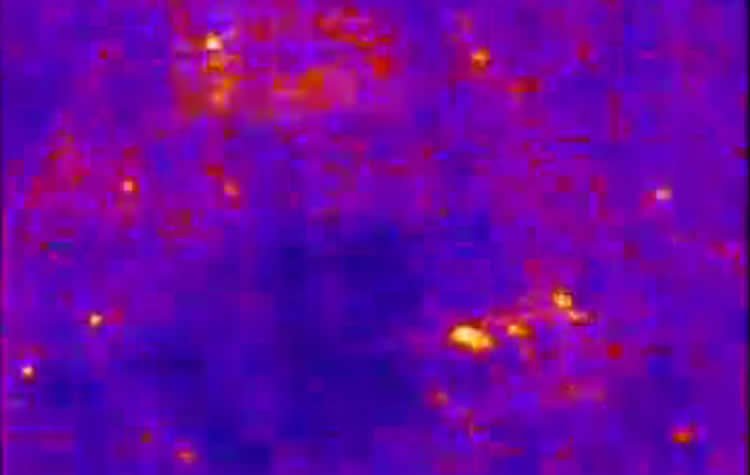Summary: Researchers have identified the neurochemical signal likely missing in Parkinson’s disease.
Source: Northwestern University.
Researchers are first to discover two distinct populations of dopamine neurons.
The method now needs validation in larger groups of patients, say the researchers.
Two Northwestern University neuroscientists have identified the neurochemical signal likely missing in Parkinson’s disease by being the first to discover two distinctly different kinds of neurons that deliver dopamine to an important brain region responsible for both movement and learning/reward behavior.
“It has been dogma for decades that all dopamine neurons are somehow involved in both movement and reward, but this didn’t really make sense,” said Daniel A. Dombeck, the study’s senior author. “Now, it is so obvious in our recordings that there are different kinds of neurons. We can literally see this in behaving animals. Our findings will likely help answer many questions about Parkinson’s disease and other neurological mysteries.”
Dombeck, an assistant professor of neurobiology in the Weinberg College of Arts and Sciences, conducted the study with postdoctoral fellow Mark W. Howe.
The findings provide a new framework for understanding the role of the dopamine system in movement control and learning/reward and how dysfunction of the dopamine system can result in a range of neurological disorders.
Prior to this study, there was little evidence for rapid movement-locked dopamine signaling in the brain. The findings were published today (July 11) by the journal Nature.
The scientists developed sophisticated imaging techniques to see what no one else has seen before: two distinct populations of dopamine neurons in the brain region of the striatum, one carrying signals for motor control and movement and the other transmitting signals about unpredicted (surprise) reward. The findings overturn the current model of how dopamine neurons influence behavior.
“There has always been this paradox about how dopamine does both movement and reward-based behavior,” Howe said. “What we found is that it does both and that there are different populations that do each one. And the neurons that do movement care about it on a very rapid timescale. These are the dynamics likely affected in Parkinson’s.”
The study provides critical information for the development of more targeted treatments of Parkinson’s, a neurodegenerative disease caused by the death of dopamine neurons. Current treatments focus on replacing ambient pools of brain-wide dopamine. This study suggests that future treatments could be more effective by targeting the specific cell types, regions and timescales that appear to be most involved in movement control.
Dombeck and Howe’s high-resolution imaging tools enabled them to observe the dynamics of the dopamine system with unprecedented detail in active mice. In studying the animals while either running on a wheel or receiving an unpredicted reward and imaging the axons of the dopamine neurons in the striatum during those activities, the scientists were able to tease apart different dopamine axons and identify the two distinct populations.

They imaged a couple of axons to many dozens of axons at a time, depending on the experiment, to see what the activity looked like. The axons related to movement and Parkinson’s were active when the animal was running but not when the animal got a reward.
Also, using optogenetics, the researchers showed they can control an animal’s movement by shining a light on genetically labeled movement axons, showing that dopamine can trigger locomotion.
“This study changes the way we think about the role of dopamine neurons in movement,” said Raj Awatramani, an associate professor in neurology at Northwestern University Feinberg School of Medicine, who was not involved in the research. “It is a very important study in the field.”
Awatramani, an expert in the molecular basis of dopamine neuron diversity, recently began a research collaboration with Dombeck and his group to further study dopamine neurons, both their function and molecular makeup.
Funding: The National Institutes of Health, Klingenstein Foundation, McKnight Foundation, and Whitehall Foundation provided funding for the study.
Source: Megan Fellman – Northwestern University
Image Source: This NeuroscienceNews.com image is credited to Staff Sgt. F. Lee Corkran/USAF.
Original Research: Abstract for “Rapid signalling in distinct dopaminergic axons during locomotion and reward” by M. W. Howe and D. A. Dombeck in Nature. Published online July 11 2016 doi:10.1038/nature18942
[cbtabs][cbtab title=”MLA”]Northwestern University. “Neurochemical Signal Likely Missing in Parkinson’s Identified.” NeuroscienceNews. NeuroscienceNews, 11 July 2016.
<https://neurosciencenews.com/dopamine-parkinsons-signaling-4659/>.[/cbtab][cbtab title=”Northwestern University”]Northwestern University. (2016, July 11). Neurochemical Signal Likely Missing in Parkinson’s Identified. NeuroscienceNews. Retrieved July 11, 2016 from https://neurosciencenews.com/dopamine-parkinsons-signaling-4659/[/cbtab][cbtab title=”Chicago”]Northwestern University. “Neurochemical Signal Likely Missing in Parkinson’s Identified.” https://neurosciencenews.com/dopamine-parkinsons-signaling-4659/ (accessed July 11, 2016).[/cbtab][/cbtabs]
Abstract
Rapid signalling in distinct dopaminergic axons during locomotion and reward
Dopaminergic projection axons from the midbrain to the striatum are crucial for motor control, as their degeneration in Parkinson disease results in profound movement deficits. Paradoxically, most recording methods report rapid phasic dopamine signalling (~100-ms bursts) in response to unpredicted rewards, with little evidence for movement-related signalling. The leading model posits that phasic signalling in striatum-targeting dopamine neurons drives reward-based learning, whereas slow variations in firing (tens of seconds to minutes) in these same neurons bias animals towards or away from movement. However, current methods have provided little evidence to support or refute this model. Here, using new optical recording methods, we report the discovery of rapid phasic signalling in striatum-targeting dopaminergic axons that is associated with, and capable of triggering, locomotion in mice. Axons expressing these signals were largely distinct from those that responded to unexpected rewards. These results suggest that dopaminergic neuromodulation can differentially impact motor control and reward learning with sub-second precision, and indicate that both precise signal timing and neuronal subtype are important parameters to consider in the treatment of dopamine-related disorders.
“Rapid signalling in distinct dopaminergic axons during locomotion and reward” by M. W. Howe and D. A. Dombeck in Nature. Published online July 11 2016 doi:10.1038/nature18942






